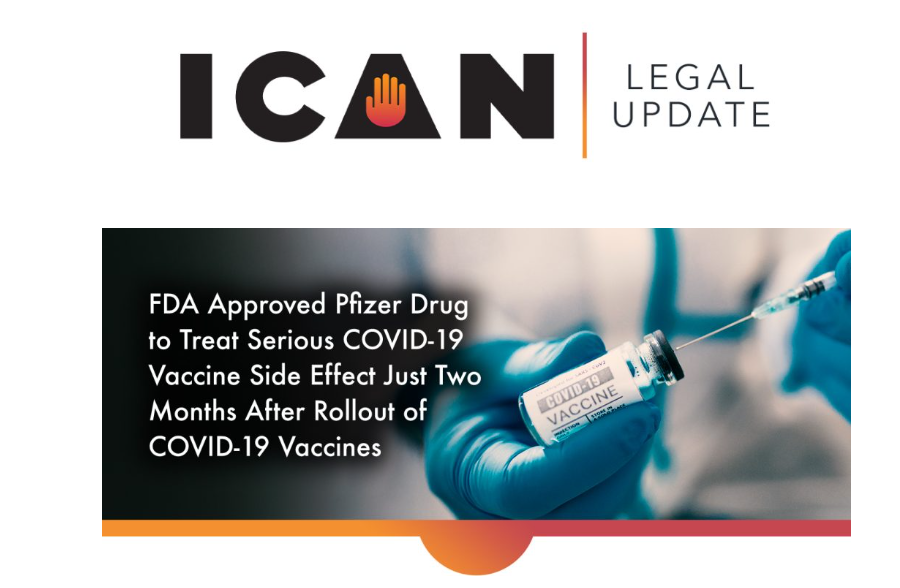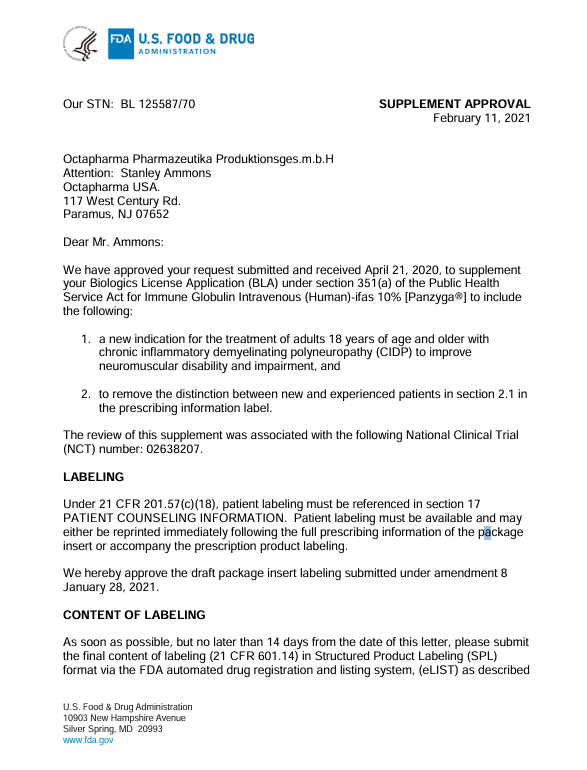🚨CRITICISMS & RESPONSES:
The following summarizes and responds to criticisms published by Henry Ford, The Conversation, and Stat News regarding the unpublished study of vaccinated versus unvaccinated children in the Henry Ford Health System.
We address these criticisms not because we must, and not to demonstrate that this is a “perfect” study, but because science demands debate. ICAN has not claimed that this unpublished study is without limitations. However, if it is thrown out, then one must throw out most of the studies in the already limited universe of post-licensure vaccine safety literature. People should carefully assess this and every study, and raise challenges, highlight limitations, and discuss flaws. That is scientific debate, and everyone should be free to engage in it and to do so without fear of professional reprisal.
(LINK: aninconvenientstudy.com/criticisms)
The following summarizes and responds to criticisms published by Henry Ford, The Conversation, and Stat News regarding the unpublished study of vaccinated versus unvaccinated children in the Henry Ford Health System.
We address these criticisms not because we must, and not to demonstrate that this is a “perfect” study, but because science demands debate. ICAN has not claimed that this unpublished study is without limitations. However, if it is thrown out, then one must throw out most of the studies in the already limited universe of post-licensure vaccine safety literature. People should carefully assess this and every study, and raise challenges, highlight limitations, and discuss flaws. That is scientific debate, and everyone should be free to engage in it and to do so without fear of professional reprisal.
(LINK: aninconvenientstudy.com/criticisms)
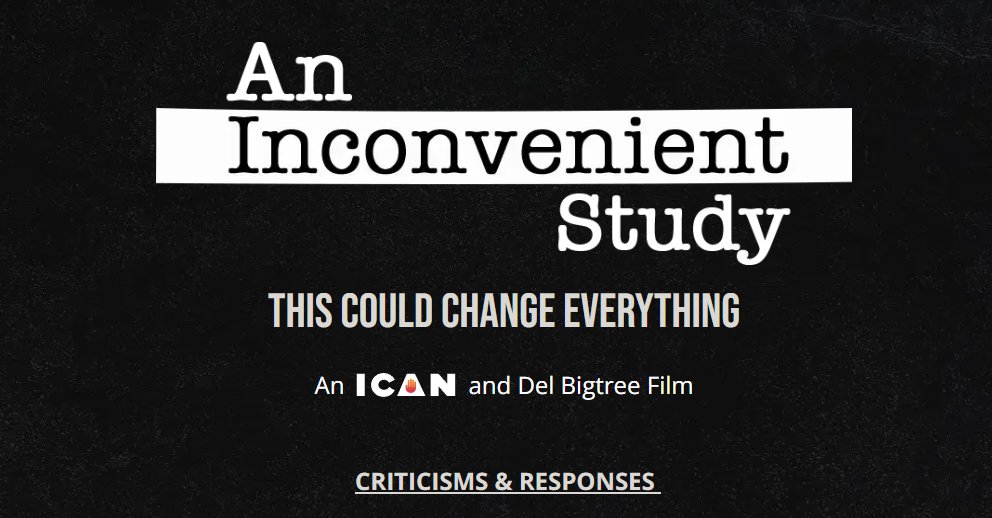
Criticism: The size of the unvaccinated group was smaller than the size of the vaccinated group.
Response: The difference in the size of the vaccinated group (16,511 children) and the unvaccinated group (1,957 children) is not a serious issue since the study calculated the “rate” between these two groups. The numbers in each group are also large enough to have statistical significance. Studies routinely compare the rate of harm between groups of different sizes, just like what was done in this study. Rejecting this study because group sizes were different would mean throwing out most studies in the medical literature.
Response: The difference in the size of the vaccinated group (16,511 children) and the unvaccinated group (1,957 children) is not a serious issue since the study calculated the “rate” between these two groups. The numbers in each group are also large enough to have statistical significance. Studies routinely compare the rate of harm between groups of different sizes, just like what was done in this study. Rejecting this study because group sizes were different would mean throwing out most studies in the medical literature.
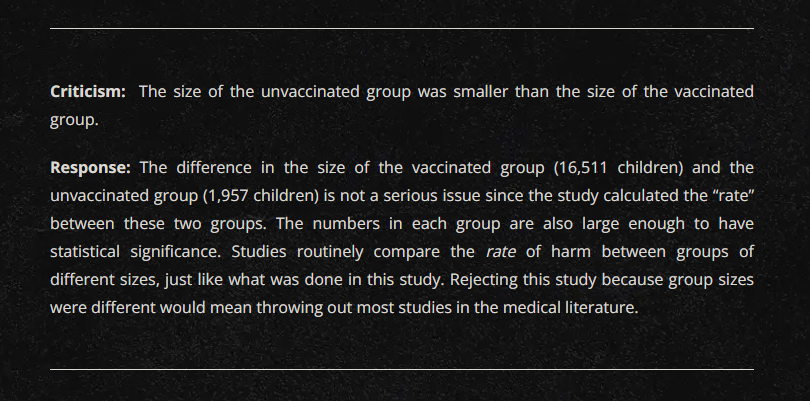
Criticism: The unvaccinated children were, on average, followed for a shorter duration and hence, were less likely to be diagnosed with a chronic disease (so-called “surveillance bias”).
Response: The unpublished study directly acknowledges and accounts for potential surveillance bias, explaining:
"Since median enrollment time was shorter in the unexposed [i.e. the unvaccinated] group, a sensitivity analysis for developing a chronic health condition was conducted for subjects enrolled in the health plan for at least 1-year, 3-years and 5-years which demonstrated consistent results. Vaccine exposure was associated with higher incidence … as well as a higher risk for developing a chronic health condition for subjects enrolled at least 1-year (HR [Hazard Ratio] 2.84, CI [Confidence Interval] 2.38-3.38), 3-years (HR 3.48, CI 2.74-4.42), and 5-years (HR 4.05, CI 2.82-5.83)."
This means that when including only children enrolled from birth and for at least five years, the result was an even higher rate of chronic health issues among the vaccinated compared to the unvaccinated children. Further, if the chronic health rate between the vaccinated and unvaccinated groups was due to differences in enrollment time, then we would expect the “HR” or “hazard ratio” number in the above quote to have gotten smaller the longer the duration of enrollment. Instead, the hazard ratio got larger.
Additionally, the CDC white paper on how to conduct a vaccinated versus unvaccinated study, which the study’s lead author agreed was followed in conducting the unpublished study, states that many more children are diagnosed with numerous relevant health outcomes from birth through the age of 2 than from ages 3-8 years old. So, the shorter time period should not have a large effect, if any, on diagnosed health outcomes. Here is a copy of the table (3.d on p. 32) from the white paper:
Regardless, even if the researchers had not done the sensitivity analysis described above, this limitation should not render the study unpublishable. To the contrary, it should, as per the scientific method, lead to additional studies that could better address this purported limitation.
Response: The unpublished study directly acknowledges and accounts for potential surveillance bias, explaining:
"Since median enrollment time was shorter in the unexposed [i.e. the unvaccinated] group, a sensitivity analysis for developing a chronic health condition was conducted for subjects enrolled in the health plan for at least 1-year, 3-years and 5-years which demonstrated consistent results. Vaccine exposure was associated with higher incidence … as well as a higher risk for developing a chronic health condition for subjects enrolled at least 1-year (HR [Hazard Ratio] 2.84, CI [Confidence Interval] 2.38-3.38), 3-years (HR 3.48, CI 2.74-4.42), and 5-years (HR 4.05, CI 2.82-5.83)."
This means that when including only children enrolled from birth and for at least five years, the result was an even higher rate of chronic health issues among the vaccinated compared to the unvaccinated children. Further, if the chronic health rate between the vaccinated and unvaccinated groups was due to differences in enrollment time, then we would expect the “HR” or “hazard ratio” number in the above quote to have gotten smaller the longer the duration of enrollment. Instead, the hazard ratio got larger.
Additionally, the CDC white paper on how to conduct a vaccinated versus unvaccinated study, which the study’s lead author agreed was followed in conducting the unpublished study, states that many more children are diagnosed with numerous relevant health outcomes from birth through the age of 2 than from ages 3-8 years old. So, the shorter time period should not have a large effect, if any, on diagnosed health outcomes. Here is a copy of the table (3.d on p. 32) from the white paper:
Regardless, even if the researchers had not done the sensitivity analysis described above, this limitation should not render the study unpublishable. To the contrary, it should, as per the scientific method, lead to additional studies that could better address this purported limitation.
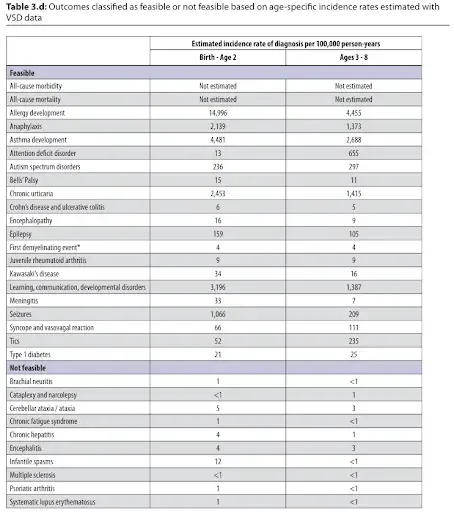
Criticism: Unvaccinated children are likely to see a doctor less often and, hence, are less likely to be diagnosed with a chronic disease (so called “ascertainment bias.”)
Response: The unpublished study directly accounts for the potential for ascertainment bias, explaining:
"Unvaccinated children have less healthcare utilization overall. Well visits coincide with the vaccination schedule and provide more opportunities for assessment and diagnosis in those receiving vaccines, compared to unvaccinated children, which could introduce an ascertainment bias. In this study, exposed children had an average of 7 annual encounters, irrespective of having a chronic health condition. Unexposed children had an average of 2 annual encounters but an average of almost 5 annual encounters if diagnosed with a chronic health condition. This likely demonstrates that when a child had a medical condition, parents sought healthcare. In fact, many conditions evaluated in this study are serious and cannot be self-treated, such as asthma, diabetes, anaphylaxis or asthma attack, warranting urgent medical attention. We nonetheless conducted several sensitivity analyses to explore the influence of healthcare utilization in order to improve the internal validity of this study and minimize potential ascertainment bias. To ensure the unexposed group’s shorter follow-up duration did not influence the results, we repeated the Cox proportional hazards analysis for the chronic health composite outcome for those in the plan for one, three and five years and for those who had at least one healthcare encounter, which demonstrated results consistent with the overall findings. The association between vaccination and developing a chronic health condition was independent of these factors. Therefore, our findings do not appear to be due to differential use of health resources."
This plainly addressed and accounted for the possibility of ascertainment bias.
The study also included a critical figure titled “10-year Chronic Disease-Free Survival by Vaccine Exposure,” reproduced below, which shows the proportion of children in the “vaccine” group and in the “no vaccine” group who had a chronic disease at each age from birth up to 10 years of age. As the figure reflects, the gap in the rate of chronic disease between “vaccine” and “no vaccine” groups gets wider the longer the children are followed from birth. For the children still enrolled at 10 years of age, 57% of vaccinated children had a chronic disease and only 17% of unvaccinated children had a chronic disease. This type of analysis is regularly used by pharma companies to show efficacy of their products and is accepted by FDA with much smaller numbers than in this study.
Response: The unpublished study directly accounts for the potential for ascertainment bias, explaining:
"Unvaccinated children have less healthcare utilization overall. Well visits coincide with the vaccination schedule and provide more opportunities for assessment and diagnosis in those receiving vaccines, compared to unvaccinated children, which could introduce an ascertainment bias. In this study, exposed children had an average of 7 annual encounters, irrespective of having a chronic health condition. Unexposed children had an average of 2 annual encounters but an average of almost 5 annual encounters if diagnosed with a chronic health condition. This likely demonstrates that when a child had a medical condition, parents sought healthcare. In fact, many conditions evaluated in this study are serious and cannot be self-treated, such as asthma, diabetes, anaphylaxis or asthma attack, warranting urgent medical attention. We nonetheless conducted several sensitivity analyses to explore the influence of healthcare utilization in order to improve the internal validity of this study and minimize potential ascertainment bias. To ensure the unexposed group’s shorter follow-up duration did not influence the results, we repeated the Cox proportional hazards analysis for the chronic health composite outcome for those in the plan for one, three and five years and for those who had at least one healthcare encounter, which demonstrated results consistent with the overall findings. The association between vaccination and developing a chronic health condition was independent of these factors. Therefore, our findings do not appear to be due to differential use of health resources."
This plainly addressed and accounted for the possibility of ascertainment bias.
The study also included a critical figure titled “10-year Chronic Disease-Free Survival by Vaccine Exposure,” reproduced below, which shows the proportion of children in the “vaccine” group and in the “no vaccine” group who had a chronic disease at each age from birth up to 10 years of age. As the figure reflects, the gap in the rate of chronic disease between “vaccine” and “no vaccine” groups gets wider the longer the children are followed from birth. For the children still enrolled at 10 years of age, 57% of vaccinated children had a chronic disease and only 17% of unvaccinated children had a chronic disease. This type of analysis is regularly used by pharma companies to show efficacy of their products and is accepted by FDA with much smaller numbers than in this study.
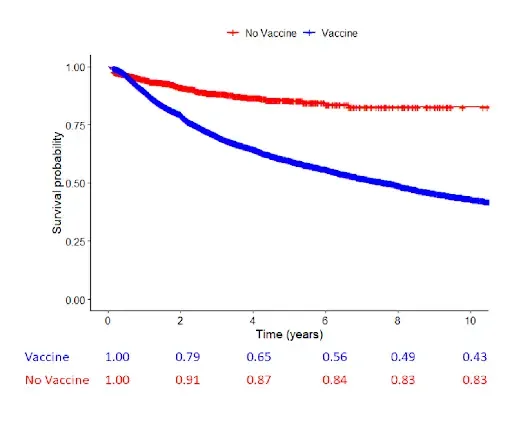
Criticism: The unvaccinated group, as compared to the vaccinated, had more males, more white children, less prematurity, and less respiratory distress at birth.
Response: Retrospective studies will have some differences in the groups being compared and they adjust for what they can and disclose what they cannot. Table 3 of the unpublished study specifically provided the “Adjusted HR [Hazard Ratio]” which expressly adjusted the results for “gender, race, birth weight, respiratory distress at birth, birth trauma and prematurity” as seen below.
Making these adjustments in studies is common practice and serves to mitigate any impact the different group characteristics (sex, race, prematurity, etc.) might have on results. As the study explains:
"As it is retrospective, we cannot exclude the possibility of unidentified confounders. However, this concern is tempered by the finding of significant associations between vaccination and particular outcomes, with some hazard ratios in the 2.5-6 times risk. We lacked information on socioeconomic status, or potentially relevant post birth factors, such as diet or lifestyle, but did adjust for several important baseline confounders such as gender, ethnicity, gestational age and birthweight. To detect the potential for uncontrolled confounding, the literature suggests evaluating disorders with no expected causal association with vaccination, a control outcome, such as injuries or cancer. Importantly in this regard we found no association between vaccine exposure and cancer."
This unpublished study adjusted for numerous variables and acknowledged others that it could not adjust for. In fact, the unpublished study adjusted for more variables than many other vaccine safety studies. It further used a medical condition that was not expected to vary between vaccinated and unvaccinated groups, in this instance cancer, as a control to detect if biases skewed the results and did not find any such issue. Again, this is common practice in medical studies and having confounders is not a basis on which to withhold publication of a study. Rather, as the study did here, researchers typically adjust for confounders where there is data to do so, disclose that other confounders may exist that are not controlled for, and suggest that additional research be conducted to validate any findings.
Response: Retrospective studies will have some differences in the groups being compared and they adjust for what they can and disclose what they cannot. Table 3 of the unpublished study specifically provided the “Adjusted HR [Hazard Ratio]” which expressly adjusted the results for “gender, race, birth weight, respiratory distress at birth, birth trauma and prematurity” as seen below.
Making these adjustments in studies is common practice and serves to mitigate any impact the different group characteristics (sex, race, prematurity, etc.) might have on results. As the study explains:
"As it is retrospective, we cannot exclude the possibility of unidentified confounders. However, this concern is tempered by the finding of significant associations between vaccination and particular outcomes, with some hazard ratios in the 2.5-6 times risk. We lacked information on socioeconomic status, or potentially relevant post birth factors, such as diet or lifestyle, but did adjust for several important baseline confounders such as gender, ethnicity, gestational age and birthweight. To detect the potential for uncontrolled confounding, the literature suggests evaluating disorders with no expected causal association with vaccination, a control outcome, such as injuries or cancer. Importantly in this regard we found no association between vaccine exposure and cancer."
This unpublished study adjusted for numerous variables and acknowledged others that it could not adjust for. In fact, the unpublished study adjusted for more variables than many other vaccine safety studies. It further used a medical condition that was not expected to vary between vaccinated and unvaccinated groups, in this instance cancer, as a control to detect if biases skewed the results and did not find any such issue. Again, this is common practice in medical studies and having confounders is not a basis on which to withhold publication of a study. Rather, as the study did here, researchers typically adjust for confounders where there is data to do so, disclose that other confounders may exist that are not controlled for, and suggest that additional research be conducted to validate any findings.
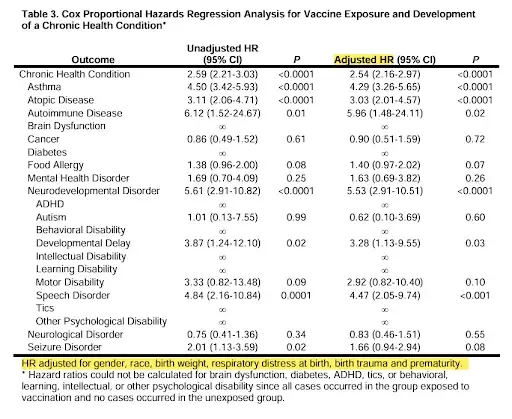
Criticism: The study did not assess which vaccines could be causing an issue.
Response: The stated purpose of the study was not to look at a specific type of vaccine or vaccine combination that could be contributing to chronic health issues. Instead, the study stated its objective was to “compare the short and long-term health outcomes, within a captured payer environment, of children exposed to one or more vaccines to those unexposed.” If an elevated risk for a chronic disease was found in the vaccinated group, further studies could then drill down into which vaccines may be causing the safety signal. That is how basic science should work. Scientists start by seeing if there is an issue with the vaccine schedule and, if so, further studies can drill down to which specific vaccines, what timing, what combination, etc., may be causing the issue.
Response: The stated purpose of the study was not to look at a specific type of vaccine or vaccine combination that could be contributing to chronic health issues. Instead, the study stated its objective was to “compare the short and long-term health outcomes, within a captured payer environment, of children exposed to one or more vaccines to those unexposed.” If an elevated risk for a chronic disease was found in the vaccinated group, further studies could then drill down into which vaccines may be causing the safety signal. That is how basic science should work. Scientists start by seeing if there is an issue with the vaccine schedule and, if so, further studies can drill down to which specific vaccines, what timing, what combination, etc., may be causing the issue.
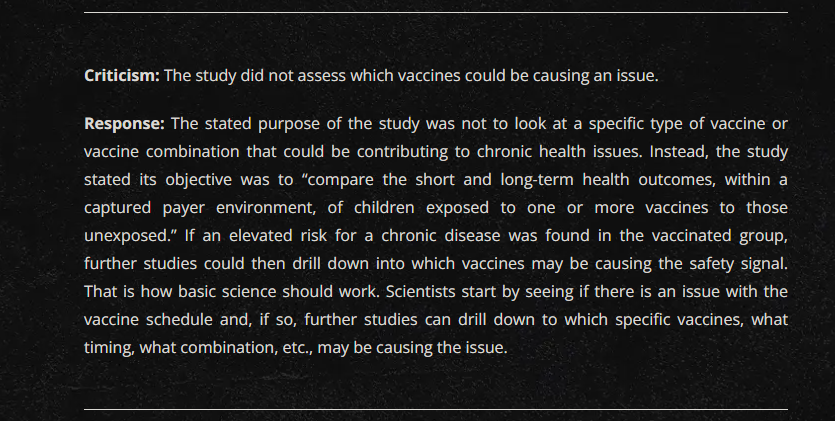
Criticism: The film claims that the study proves vaccinated kids have more chronic health issues than unvaccinated children.
Response: The film does not portray the unpublished study as conclusive proof of anything. To the contrary, the film states: “Can we say that the Henry Ford study proves that vaccines are causing the chronic disease epidemic? No, we cannot. A retrospective study does not prove causation. What we can say is that we believe it is showing a signal – a red flag waved in the air by the scientific method.” The film raises questions about the reasons the study was not submitted for publication, acknowledges and addresses the limitations, and highlights the need for further studies to be done—especially given that there is, separate from this unpublished study, a growing body of studies that have compared vaccinated children to completely unvaccinated children and reached similar results.
Response: The film does not portray the unpublished study as conclusive proof of anything. To the contrary, the film states: “Can we say that the Henry Ford study proves that vaccines are causing the chronic disease epidemic? No, we cannot. A retrospective study does not prove causation. What we can say is that we believe it is showing a signal – a red flag waved in the air by the scientific method.” The film raises questions about the reasons the study was not submitted for publication, acknowledges and addresses the limitations, and highlights the need for further studies to be done—especially given that there is, separate from this unpublished study, a growing body of studies that have compared vaccinated children to completely unvaccinated children and reached similar results.
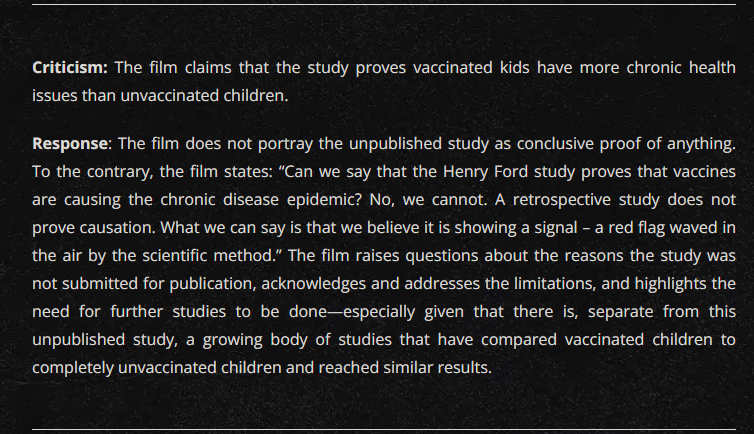
Criticism: The number of autism cases appears to be below what would be expected.
Response: One potential reason for this is that the unpublished study covered the period 2000 to 2016, and it is likely that many of the autism cases at that time would have been classified as ADHD cases. This is because, until 2012, the official medical diagnostic manual (the DSM-IV) did not permit diagnosing a child with autism and with ADHD. The physician had to pick one and was more likely to pick ADHD because: billing codes tied to the DSM-IV prioritized single diagnoses for reimbursement; diagnosing ADHD was far simpler than diagnosing autism; there was medication-based treatment for ADHD but none for autism; and physicians were more comfortable with treating ADHD over autism. That changed in 2013 when the DSM-V was published, and a doctor could diagnose and bill for both ADHD and for autism. Thus, for only three of the sixteen years covered by the unpublished study were doctors likely to diagnose both conditions.
The foregoing is reflected in the ratio of ADHD to autism cases in the unpublished study. While the ratio should have been close to one case of autism for every three cases of ADHD based on current diagnosing statistics, the study reported one case of autism for every eleven cases of ADHD.
Response: One potential reason for this is that the unpublished study covered the period 2000 to 2016, and it is likely that many of the autism cases at that time would have been classified as ADHD cases. This is because, until 2012, the official medical diagnostic manual (the DSM-IV) did not permit diagnosing a child with autism and with ADHD. The physician had to pick one and was more likely to pick ADHD because: billing codes tied to the DSM-IV prioritized single diagnoses for reimbursement; diagnosing ADHD was far simpler than diagnosing autism; there was medication-based treatment for ADHD but none for autism; and physicians were more comfortable with treating ADHD over autism. That changed in 2013 when the DSM-V was published, and a doctor could diagnose and bill for both ADHD and for autism. Thus, for only three of the sixteen years covered by the unpublished study were doctors likely to diagnose both conditions.
The foregoing is reflected in the ratio of ADHD to autism cases in the unpublished study. While the ratio should have been close to one case of autism for every three cases of ADHD based on current diagnosing statistics, the study reported one case of autism for every eleven cases of ADHD.
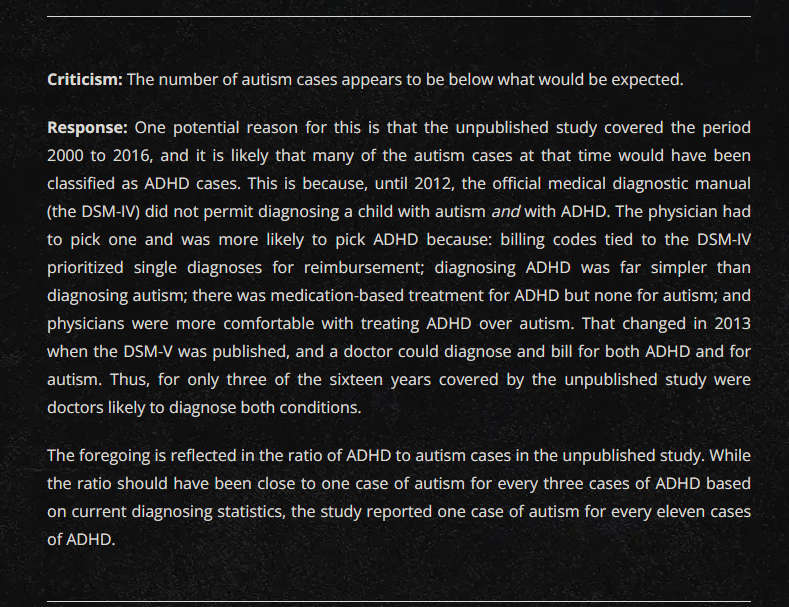
In sum, retrospective studies always have limitations and confounders and this unpublished study, like all other retrospective studies, seeks to address those in the manners described above and by other means discussed in the study. These retrospective studies then disclose the potential confounders and how, where possible, they have been mitigated. That is what occurred here where this study sought to mitigate the very confounders that the critics have complained about. In fact, many vaccine safety studies have far more concerning confounders, including those that are undisclosed and/or unmitigated.
The foregoing concerns raised by a handful of individuals, if anything, appear to further beg the question of why this study was not submitted for peer review and published. These criticisms, in addition to the undercover footage and all the facts set forth in the film and on this page, deepen ICAN’s opinion that had the study found that the vaccinated children were healthier, the study would have been submitted for publication. ICAN stands by its opinion that because it showed the opposite, the unpublished study was not submitted for publication. At the very least, this unpublished study raises critical questions. Parents should ask questions and demand answers and researchers should conduct additional studies to further our understanding of these products that we inject into our healthy children dozens of times starting on day one of life.
• • •
Missing some Tweet in this thread? You can try to
force a refresh


